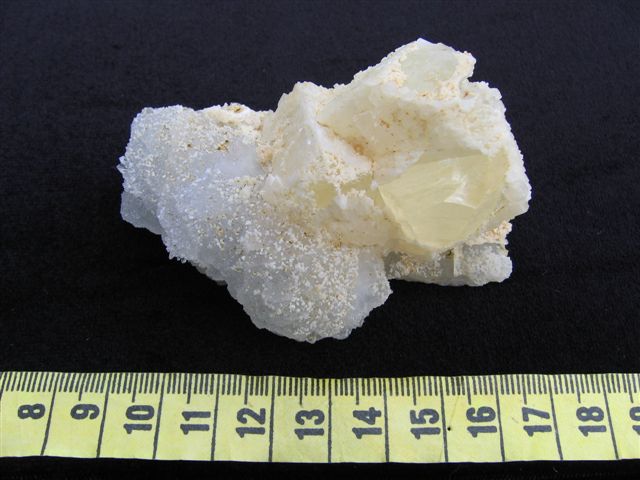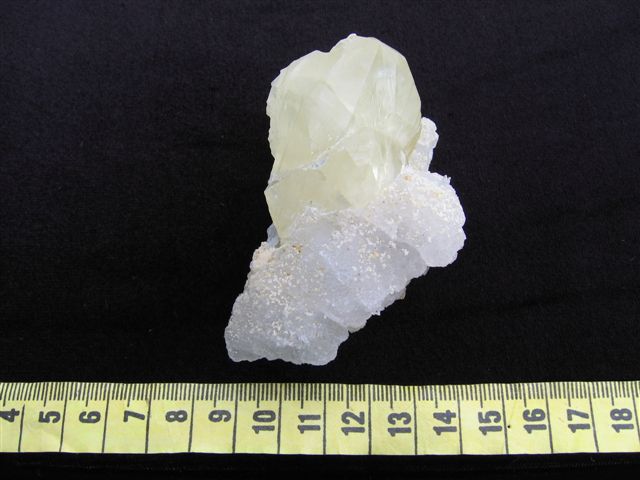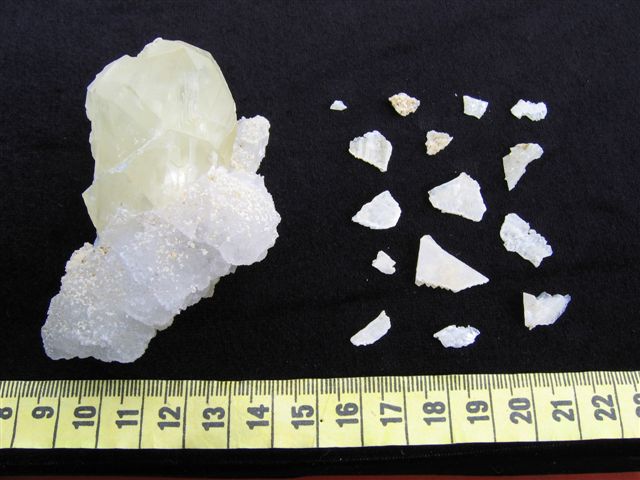Inspiration and an Exceptional Calcite
Mill Creek Quarry
Polk County, Oregon
May 17, 2005
John Cornish
(cornish@tfon.com)
The Mill Creek Quarry near Buell, Oregon has had a rich history, primarily among Oregon and Washington field collectors, as an intermittently active locality where crystalline mineral specimens of several zeolites and their associated species may be collected. Numerous accounts have been written of this locality and its minerals and some of these are offered at the end of this paper for your further consideration. Among these is the paper I wrote back in 1997 which describes, "One exceptional group of yellow calcites, which came from a large pocket, is overgrowing clear stilbite and quartz and is 1 1/2 by 1 1/2 by 2 inches (3.8 by 3.8 by 5.1 cm) and is in turn partially overgrown by a thin layer of crystallized white calcite". No photos were shown of this "exceptional" specimen because to be honest, it may of been exceptionally large, but it was also exceptionally ugly.
That is, with its white calcite overgrowth. Beneath that though, the yellow calcite that peeked out from under the crud was glorious. It was bright and lustrous, gemmy and awesome. But under this later overgrowth, this killer calcite lay, a great one off specimen if still, the largest calcite from this locality I've ever seen. And that's the way things have sat since then, back in 1997. Which brings us to the present... almost.
Back in 2001, Bert Ottens presented a wonderful talk at the 28th Annual Rochester Mineralogical Symposium on the Cavity Minerals From The Deccan Volcanic Province, India. During this talk, he spoke of the incredible prismatic calcites from Jalgaon. These calcites occur as the first of two calcite generations as related by Ottens in this presentation and in his following 2003 monograph published by the Mineralogical Record titled Indian Zeolites and Related Species. They were incredible things these calcites excepting one thing, they were always overgrown by quartz, sometimes associated further with stilbite and apophyllite in crystals up to 1 foot (30 cm) long! Awesome things excepting that darn overgrowth... and just like that, the gears started to slowly turn and lightning like the image of that old calcite from that 1997 Mill Creek paper jumped into my mind and in less time then it takes to write or read of it, I was off and into the boxes hunting out that exceptional calcite, the same one I'd written about all those long years before.

Without too much effort I found the specimen and it was exactly as I'd remembered it, a good one off. Ottens had mentioned that the Jalgaon quartz layer was often 0.5 to 2 mm thick (equation, darn thin up to just a tad over a 1/16 of an inch) and that he could attach a glue gun to the quartz layer (carefully so as not to shock the calcite) and that once it'd dried, he could quickly wrench at the gun and with luck separate the quartz from the calcite. The three examples he showed where he'd successfully accomplished this feat where shocking, mind numbing things, clear colorless crystals with wonderful rare forms often accompanied by glowing green phantoms. They were beautiful things, but in 20 attempts, only 3 specimens were successfully liberated from their distracting quartz coverings. What's that tell me; no guts no glory!
At my work table (the front porch in the full blaze of a rare sunny Spring day) I began my task. First I scrutinized the specimen, for the first time in years, and noted that the rhombic calcite overgrowths varied from minute clumps of individuals to larger and thicker coatings just over an 1/8 inch (3.2 mm) thick. Humm, I'd have my work cut out for me! The wrenching glue gun style seemed kind of brutal to me and I began hunting for a less violent means to remove the offending calcite layer and was surprised and hopeful to find that with just the right amount of pressure applied from just the right angle, I could actually fleck the offending overgrowth away and even more importantly, leave the underlying calcite perfect and undamaged. I was ecstatic and was soon hunched over my specimen, whittling away at it and shredding my fingernails every step of the way. I only slipped once and sliced the skin of my knuckle open, ah look, pretty red calcite!

I kept at it and was amazed to find that with patience, not trying for everything at once, that I was able to progress steadily around the crystals revealing more and more of the treasure beneath. It was a fun if not slightly intense experiment and with more success then I'd ever hoped for, a startlingly beautiful specimen was slowly emerging. No surprises, faster on the wide flat faces and slower at the edges so as not to cleave the calcite beneath and then with my heart in my throat and my new glorious specimen in hand, it was done and what a yummy thing had been revealed, and that, perfectly.

Every clump and chunk, every offending everything was gone. Before me was the finest calcite I've ever seen from this locality and here it'd sat, buried in a box hidden in the shadows under a layer of crud, but no more, what a winner! It'd taken time, a bit of effort and a drop or two of blood, but it was worth the effort and now as I write in reflection, I only wish I had another 19 specimens to try so as to see if I could beat Bert's 3 of 20 record. Ah well, odds are perhaps I'd have done it, after all my calcite is much softer then Bert's offending quartz and when combined with calcites easy cleavage, surely this aided my efforts.
Treasure lies all about as can the inspiration that propels us to find it. Seek and ye shall find! All the very best everyone, take care,
List of References
John Cornish, J. 1997. Minerals From The Mill Creek Quarry, Polk County, Oregon. Mineral News Vol. 13, No. 8.
Howard, D. 1997. New Minerals (At Last) From Mill Creek Quarry, Buell, Polk Co., Oregon. Micro Probe Vol. 8, No. 6.
Howard, D. 1995. Mill Creek Quarry, Buell, Polk County, Oregon. Micro Probe Vol. 8, No. 2.
Ottens, B. 2001. Cavity Minerals From The Deccan Volcanic Province, India. 28th Annual Rochester Mineralogical Symposium video.
Ottens, B. 2003. Minerals of the Deccan Traps, India. Mineralogical Record Vol. 34, No. 1.
Ream, L. 1991. Mill Creek Quarry Still Open. Mineral News Vol. 7, No. 6.
CLICK THE LITTLE MINER TO RETURN TO THE FIELD TRIP PAGE
